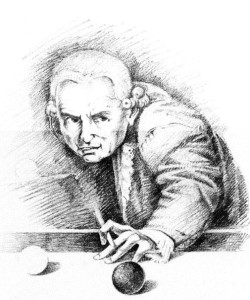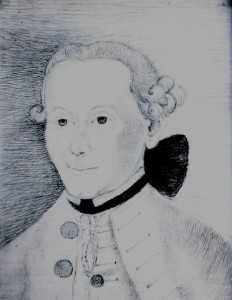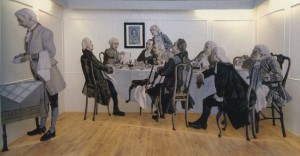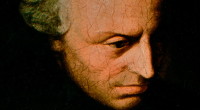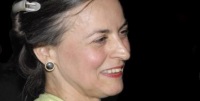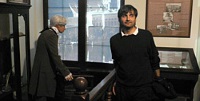A. Trotsak. 8 Myths About Kant
Immanuel Kant has created a philosophic system that is still unequalled. And there are many myths around his name that have been implanted in the minds of most people. Dear readers, let us consider the most common myths about Kant and compare them to what really happened.
Preface
I would like to inform the reader that creation of the article below was inspired by my teacher, Vladimir Bryushinkin, Ph.D., who, tragically, has passed away. Moreover, the work is based on the material provided by Vladimir Bryushinkin. Also a lot of historical data in this article originate from « Kantovskij Sbornik». The illustrations are just a small share of the work performed by Kant Institute workers (Immanuel Kant Baltic Federal University) who have organized existing images of Kant. I would like to especially thank Ksenia Fomichyova. Kant’s poems were translated by me.
This article was first published at Kaliningrad.ru portal
Briefly about myths
Traditionally, a myth is defined as a folk tale that contains people’s apprehension of the world, a man’s place in it, the origin of everything that exists, gods and heroes. Mythology was common in primitive cultures, but even now myths are a source of information…
Myth #1: mystery of the name
Immanuel Kant was born on April 22, 1724 in Koenigsberg into a saddler’s family. He was baptized by the name of Emanuel, which could be found in the Old Prussian Almanach for this date. However, afterwards he changed it to Immanuel. All his life Kant was proud of the name given to him and considered it more suitable for him.
Myth #2: Kant’s insensibility
There were nine children in Kant’s family, but some of them did not live long. Immanuel was the fourth child. The family was modest and religious. Kant’s mother, despite her early death in 1737, was the biggest influence on him. She belonged to the branch of Protestantism called pietism. It highlighted personal devotion of every individual. This resulted, in particular, in inner acceptance and strict compliance with moral rules.
Kant’s mother taught him his first lessons of loving attitude towards the world. Afterwards Kant said to one of his bibliographers R. Yachman: “I will never forget my mother because she planted and nurtured the first sprouts of good in me, she opened my heart to the impressions of the nature…” (Cit.: Vorländer K. Immanuel Kant. Der Mann und das Werk. Dritte Auflage. — Hamburg: Felix Meiner Verlag, 1992. S. 17).
Myth #3: Kant’s incomprehensible language
“The critique of pure reason” is considered to be one of the most complicated works of the great philosopher. In more than a century after Kant’s death Max Epstein published his book “Immanuel Kant. The critique of pure reason in _______” that versified the complicated language of the work. The claim to be able to versify Kant’s “The critique of pure reason” makes it noticeable for readers. “The critique of pure reason” was repeatedly published, translated to various languages, and thus had an even more considerable influence on German and world philosophy.
Kant did not write the «Critique» for a wide audience and did not recommend to start exploring his philosophy with it. Despite these precautions Epstein chooses a particular poetical form – stanzas (Stance (fr.) – a grouped set of lines within a poem, in poetry of XVIII-XIX a small elegiac poem with simple structure and meditative content) – and attempts to express Kant’s ideas using it. Below is an extract that characterizes Kant’s transition from theoretical to practical philosophy:
I belief in a priori laws,
Which define the effect of morality,
They say: without complete happiness,
Earth bases of good and evil,
Which people are follow,
Without violating any law,
One may achieve the highest knowledge;
I belief: man is striving for goodness,
He wanders alone while he lives his age.
Myth #4: Kant never left Koenigsberg
His first place to work was the house of reformist priest Adersh in Judtschen village (current Veselovka village of the Gusev district). Apparently, Kant stayed in Judtschen till 1750, and then became a house teacher in the house of Major Bernhard Friedrich von Huelsen in Gross-Arnsdorf between Elbląg and Osterode. It is usually thought that the third house Kant worked in as a teacher was Rautenberg, the house of count Keyserling in Tilsit-Niederung district, however some researchers, for instance, Karl Forlander, tend to question this fact. In any case, it is known that in August of 1754 Immanuel Kant came back to Koenigsberg.
Myth #5: Kant avoided any contact with women
It is believed that Kant only loved his metaphysics, as he also wrote himself. However, historic evidence says otherwise.
Kant’s personal life was not successful in a usual sense. He never got married, though according to biographers, twice he intended to. However, Kant was not called «Gallant Magister» for nothing. As the philosopher enjoyed visiting the elite gatherings of Koenigsber, it is not impossible that there was mutual attraction between him and some representatives of the fair sex. We only know several details of Kant’s friendship with beautiful Maria Charlotte Jakobi-Goschen, wife of merchant Jakobi. Together with Goschen, director of the mint, he was included in her retinue and escorted her to theaters, balls and masquerades. Two of her letters to Kant are left available, both of which contain orthographic errors. Below is the first one of them:
«Dear Friend,
Aren’t you surprised that I dare to write to you, a great philosopher? I thought I would find you in my garden yesterday, but since my girlfriend and I crept through all the alleys and failed to find our friend under this circle of heaven I spent my time finishing a rapier ribbon, it is dedicated to you. I make claim on your company tomorrow afternoon. I hear you say, “Yes, yes, I’ll come.” Well good, we shall await you and then my watch will get wound… » (See: Конен Й. странная дружба Иммануила Канта: Мария Шарлота Якоби-Гёшен // Kantovskij Sbornik. Issue. 19. Kaliningrad, 1995. P., 144 — 158. P., 147)
Later Kant was in fact presented with the rapier ribbon that he refused as soon as the French revolution began, according to F. Hause. Many biographers consider the phrase about the “clock being wound” as a hint to some kind of intimate relationship, however we might not have the right to insist on this: Kant was a very famous and respectable man, and many people were attracted to him, craving to be in his acquaintance circle and thus raise their profile.
In late 60-s of XVIII Kant entered the social circle of count von Keyserling who played an important in Koenigsberg culture of that time. He established especially warm relationship with countess Keyserling whom he viewed as a «perfect woman». He maintained this relationship for 30 years. After her death in 1791 he called her an «adornment of her sex» and refused almost all of his contacts with women.
Myth #6: Kant was a stranger to arts
In December of 1758 the position of professor of logic and metaphysics became available again. Kant applied for this position. The Academic board chose two out of five candidates – F.J. Buck, a mathematician, and Kant. As a subject of the Russian Empire, in accordance with the standard procedure Kant had to apply to empress Elizabeth for a permission to be a professor. The final decision was not made in favor of the philosopher. The position was given to Buk, as he was older and had more teaching experience. Only in 1764 Minister of justice offered Kant the position of professor of poetry and eloquence. As strange as it is, it happened after Buck’s death. Kant declined the offer, which was appreciated.
Kant received a rescript from the king promising to offer him an available position as soon as possible. In 1765 Kant, in accordance with the promise made by the ministry, Kant started to work as a librarian’s assistant in the Königsberg Castle. This work did not take much effort and provided Kant with the opportunity to continue teaching and researching. However Kant never gave up his interest in poetry. During his university years Kant wrote epitaphs for his deceased friends. Interestingly, Kant managed to express his philosophic thoughts through his poetry:
To doctor Lestock, military counselor and professor of law in Koenigsberg (1780)
Myth#7: Kant loved loneliness
At the age of 46 (1770) Kant gained the permanent position of professor of logic and metaphysics. Twice, in 1786 and 1788, he was a chancellor of Koenigsberg University. In 1783 Kant bought a house on the Prinzessin-strasse near the Custle. In this very house his life took its final form. It hosted the famous dinners; he went out from it for his even more famous walks – the rule he kept even at an advanced age. Dinners at Kant’s were a separate matter in his life; they had a conversational nature rather than were they a simple food intake. Kant never liked to dine alone, but always over a conversation. Such dinners went on for two or even three hours. While the philosopher was poor he preferred to dine in a tavern where he could always find a company.
When he bought the house he used to invite for a dinner his friends from among the Koenigsberg noblemen or merchants from whom he heard a lot of interesting stories about the events from outside Koenigsberg. Being concerned about his company not to come apart Kant laid down a useful rule – the number of guests should be no less than the number of Graces and by no means more than the number of Muses. According to the most widespread opinions this number was three or four. As a consequence the number of people at the table including the host can’t be less than 4 or 5 otherwise conversation won’t be diverse enough and could turn out to be boring. The main rule for participants was to talk about anything but philosophy.
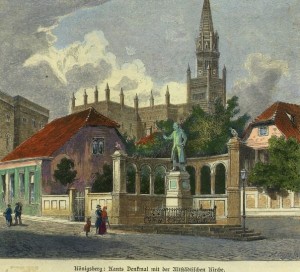
Kant’s statue and Altstadt church. Colored engraving on wood. A. Klotz based on drawing by G. Schenbler. Koenigsberg museum. 1881
Myth#8: Kant said “Gut” and left this world
In the summer of 1796 Kant read his last lectures at the university, however he quit the position in the university staff only in 1801. From 1802 the philosopher started to grow weak. According to Kant’s own confession his strengths were fading away even though he didn’t suffer any particular illness, – so he wrote to Rheingold. The philosopher had to stint his traditional dinners because it was difficult for him to remain standing for a long period of time. His famous walks became shorter as well.
It is already in December of 1803 that Kant could not write his own name legibly. The food had no taste anymore, his voice could barely be heard (his speech was hard to distinguish). On February 6 his condition took a turn to worse, and since February 7 he remained in bed. Wasianski stayed with the philosopher during the last days of his life. On 11th of February the biographer sitting next to Kant’s bed asked him whether Kant recognizes him. Kant slowly pushed out his lips for a kiss of gratitude for a many years of friendship and assistance. The student was astonished: he couldn’t recall Kant kissing anyone ever. On 12th of February at 1pm Kant made his last sip of water and pronounced the last word of his life: “Gut”. The city took Kant’s death as a tragedy.
Conclusion
Kant as an individual does not exist anymore, but his glory and his words are still alive. His attempts to answer the deepest questions of reality cleared up and resolved many problems of science. The last paradox of Kant as a thinker is that even being physically dead for over 200 years he remains alive for the humanity.
Kant is one of those who achieved, even if it took him restraining his own life, but he was able to leave to progeny not scandalous details of his existence, but precise and deliberate thought which yields till the present day.
What follows after life is covered with the veil of darkness
For all we do only we are responsible.
(I. Kant. Epitaph to doctor Theodor Christoph Lilienthal)



